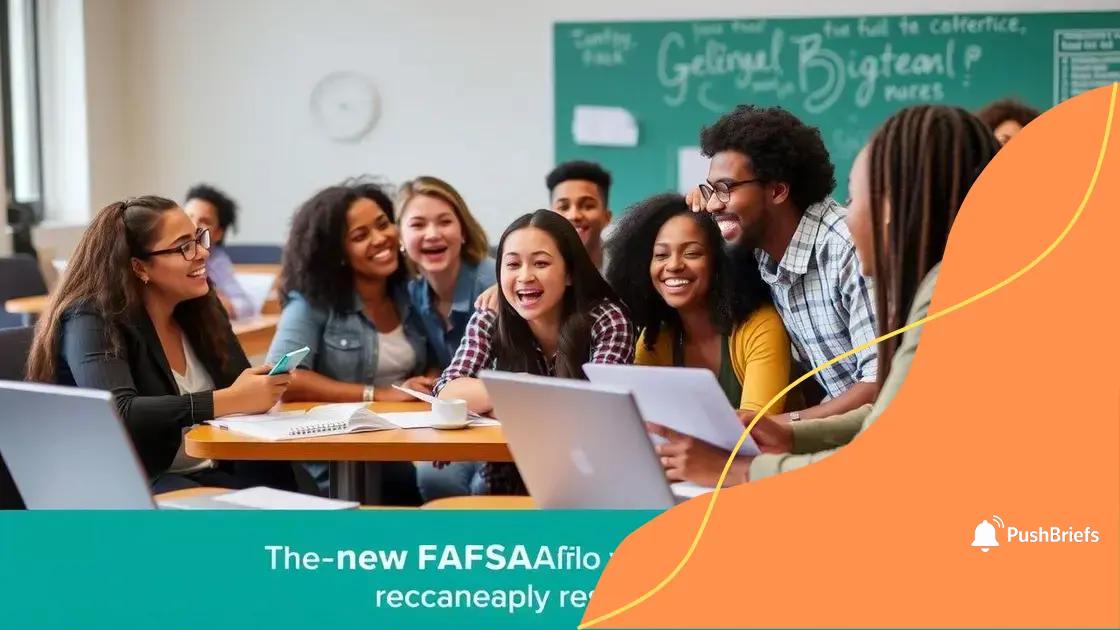FAFSA simplification implementation: what you need to know

FAFSA simplification reduces application questions and automates data retrieval, making it easier for students to access financial aid for college.
FAFSA simplification implementation is reshaping the landscape of financial aid for students across the country. Have you ever felt overwhelmed by the FAFSA process? In this article, we’ll delve into the key changes and how they can make your life easier.
Understanding the FAFSA process
Understanding the FAFSA process is crucial for students seeking financial aid for college. The Free Application for Federal Student Aid (FAFSA) helps determine your eligibility for federal, state, and college-specific aid. Filling it out accurately can significantly impact your education funding.
What Information is Required?
To complete the FAFSA, you’ll need various financial details. This includes your income, tax returns, and information about your family’s financial situation. Be prepared to provide:
- Your Social Security number
- Your driver’s license number (if applicable)
- Financial information from your tax returns
- Records of untaxed income, such as child support
Gathering these documents beforehand can save you time when completing the application.
How to Fill Out the FAFSA
Once you have all the required information, you can start filling out the FAFSA online. Here are the steps:
- Create an FSA ID to sign your application electronically.
- Visit the FAFSA website and select “Start a New FAFSA”.
- Follow the prompts and fill in your information accurately.
Be sure to double-check your details for any errors that could delay your aid.
After submitting your application, keep an eye out for your Student Aid Report (SAR). This document summarizes your information and lets you know your Expected Family Contribution (EFC). Understanding your EFC is important as it helps determine your financial aid package.
Remember, the FAFSA must be completed each year you want financial aid. Staying on top of the deadlines will ensure you receive the necessary funding for your education.
Key changes in FAFSA simplification
Key changes in FAFSA simplification are making it easier for students to access financial aid. These modifications will streamline the process, potentially increasing the number of applicants who receive assistance.
Reduction of Questions
One significant change is the reduction in the number of questions on the FAFSA form. Fewer questions mean that students can fill out the application more quickly. This change is intended to decrease the time and confusion associated with completing the form.
- The application will now focus on essential information.
- Students can expect a clearer, more concise format.
- This simplification targets first-time applicants.
By eliminating unnecessary questions, the FAFSA becomes more user-friendly. Students will appreciate the time saved and experience less frustration during the application process.
Automatic Re-evaluation of Income
Another key aspect of this simplification is the automatic re-evaluation of income for families. Instead of requiring families to repeatedly input their financial information each year, the FAFSA will link to IRS data, such as tax returns. This approach promotes accuracy since it reduces the chances of errors.
With this automation, students will have a smoother experience when applying for financial aid. They can trust that their financial details are accurate and up-to-date. Furthermore, this process safeguards personal information by securely transferring data directly from the IRS.
Understanding these key changes can empower students to navigate their financial aid journeys with confidence. Simplifying these aspects of the FAFSA can lead to a more inclusive educational environment by making financial assistance more accessible.
How these changes impact students

Understanding how these changes impact students is vital as they navigate their financial aid options. The recent FAFSA simplification makes the application process less daunting, potentially leading to more students accessing funds for their education.
Increased Accessibility
With fewer questions and streamlined requirements, more students may feel encouraged to apply. This simplification addresses common barriers that discourage applicants. Greater accessibility is likely to result in:
- A higher number of students submitting their FAFSA applications.
- More equitable distribution of financial aid across various demographics.
- Increased awareness of available funding opportunities.
As the barrier to entry lowers, students from diverse backgrounds can benefit from federal assistance, leading to a more educated population.
Time Savings
The time saved from filling out the FAFSA can be significant for students. With automatic data retrieval from the IRS, students can quickly complete their applications. This allows them to focus on other essential tasks, such as:
- Researching colleges and scholarship opportunities.
- Preparing for exams and enhancing their academic portfolios.
- Engaging in extracurricular activities that strengthen their college applications.
Consequently, students will be able to invest their time efficiently, enhancing both their academic and personal growth.
Overall, the simplification of the FAFSA process is expected to create a more positive atmosphere for students. By prioritizing efficiency and accessibility, these changes can result in better financial support and academic opportunities for all.
Steps for a smoother application
Following the right steps can lead to a smoother application process when filling out the FAFSA. These steps help ensure that you have all the necessary information and understand what is required.
Prepare Your Documents
Before starting the FAFSA application, gather essential documents. Having everything you need in one place can save time and frustration. Important documents include:
- Your Social Security number or Alien Registration number.
- Your driver’s license (if applicable).
- Your parents’ financial information if you are a dependent student.
- Tax returns from the previous year for both you and your parents.
By organizing these documents beforehand, you can complete the application faster and minimize errors.
Fill Out the Application Online
Start your application by visiting the FAFSA website. Here’s how to proceed:
- Create your FSA ID to log in securely.
- Follow the prompts to enter your information.
- Review your entries carefully before submitting.
Filing online is beneficial because it allows you to save your application and return to it later if needed. This flexibility gives you time to ensure everything is accurate.
After submitting the application, expect to receive your Student Aid Report (SAR). This document summarizes your data and indicates your Expected Family Contribution (EFC). Review it carefully to ensure all information is correct. If you discover any errors, correct them as soon as possible to avoid delays.
Taking these steps will help make your FAFSA application experience much easier. The more prepared you are, the more confident you will feel about receiving the financial aid you need.
Resources for navigating financial aid
Having the right resources for navigating financial aid can make a significant difference in the FAFSA application process. Many tools and organizations are dedicated to helping students, ensuring they receive the aid they need to succeed.
Online Websites and Tools
Numerous websites can guide students through the financial aid process. These resources often provide tips, FAQs, and step-by-step instructions. Some useful online tools include:
- The official FAFSA website, which offers information and application forms.
- Scholarship search engines like Fastweb and Cappex that find funding opportunities.
- Collegeboard.org, which includes a financial aid calculator.
Utilizing these sites helps students and families access vital information and resources efficiently.
Workshops and Webinars
Many schools and community organizations host workshops and webinars focusing on financial aid. Attending these sessions can provide valuable insights. They often cover important topics such as:
- How to complete the FAFSA accurately.
- Understanding the types of financial aid available.
- Tips for applying for scholarships and grants.
These interactive experiences encourage questions, allowing students to clarify any uncertainties about the process.
Moreover, high school counselors can be valuable resources. They are often trained to help students understand and navigate financial aid options. Students should not hesitate to reach out to them for guidance.
Utilizing these various resources for navigating financial aid can help demystify the process. By being proactive and informed, students can improve their chances of receiving the financial assistance they need for their education.
In summary, understanding the FAFSA simplification can greatly benefit students seeking financial aid for college. By knowing the key changes and steps involved, students can make informed choices and potentially secure the funding they need. Utilizing available resources, such as online tools, workshops, and school counselors, empowers students during the application process. With less complexity and more guidance, the path to higher education can be clearer and more accessible for everyone.
FAQ – Questions about FAFSA simplification and financial aid
What is FAFSA simplification?
FAFSA simplification refers to the changes made to the Free Application for Federal Student Aid process to make it easier for students to apply for financial aid.
How does FAFSA simplification impact students?
It reduces the number of questions on the application and allows for automatic data retrieval, making it quicker and easier for students to complete.
What resources are available for filling out the FAFSA?
Students can use online tools, attend workshops, and speak with school counselors to help them navigate the FAFSA process.
Why is it important to complete the FAFSA each year?
Completing the FAFSA every year is essential to maintain eligibility for financial aid, as your financial situation can change annually.
